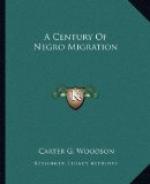houses, also with store and out houses. In nine
months he had made and housed three crops of corn,
of twenty-five bushels to the acre, each, or one crop
every three months. His highland rice, which was
equal to any in Carolina, so ripe and heavy as some
of it to be couched or leaned down, and no bird had
ever troubled it, nor had any of his fields ever been
hoed, or required hoeing, there being as yet no appearance
of grass. His cotton was of an excellent staple.
In seven months it had attained the height of thirteen
feet; the stalks were ten inches in circumference,
and had upwards of five hundred large boles on each
stalk (not a worm nor red bug as yet to be seen).
His yams, cassava, and sweet potatoes, were incredibly
large, and plentifully thick in the ground; one kind
of sweet potato, lately introduced from Taheita (formerly
Otaheita) Island in the Pacific, was of peculiar excellence;
tasted like new flour and grew to an ordinary size
in one month. Those I ate at my son’s place
had been planted five weeks, and were as big as our
full grown Florida potatoes. His sweet orange
trees budded upon wild stalks cut off (which every
where abound), about six months before had large tops,
and the buds were swelling as if preparing to flower.
My son reported that his people had all enjoyed good
health and had labored just as steadily as they formerly
did in Florida and were well satisfied with their situation
and the advantageous exchange of circumstances they
had made. They all enjoyed the friendship of
the neighboring inhabitants and the entire confidence
of the Haytian Government.”
“I remained with my son all January, 1838 and
assisted him in making improvements of different kinds,
amongst which was a new two-story house, and then
left him to go to Port au Prince, where I obtained
a favorable answer from the President of Hayti, to
his petition, asking for leave to hold in fee simple,
the same tract of land upon which he then lived as
a tenant, paying rent to the Haytian Government, containing
about thirty-five thousand acres, which was ordered
to be surveyed to him, and valued, and not expected
to exceed the sum of three thousand dollars, or about
ten cents an acre. After obtaining this land in
fee for my son, I returned to Florida in February,
in 1838.”—See The African Repository,
XIV, pp. 215-216.]
[Footnote 22: Niles Register, LXVI, pp.
165, 386.]
[Footnote 23: Niles Register, LXVII, p.
180.]
[Footnote 24: The African Repository,
XVI, p. 28.]
[Footnote 25: Ibid., p. 29.]
[Footnote 26: Letter of Mr. Stanbury Boyce.]
[Footnote 27: St. Lucia and Trinidad were then
considered unfavorable to the working of the new system.—See
The African Repository, XXVII, p. 196.]
[Footnote 28: Niles Register, LXIII, p.
65.]
[Footnote 29: Ibid., LXIII, p. 65.]
[Footnote 30: Cromwell, The Negro in American
History, pp. 43-44.]




